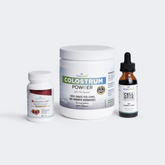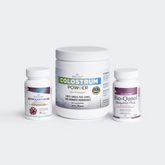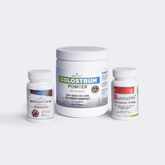Estimated Reading Time: 7 minutes
|Estrogen — the hormone of vitality, strength, and reproductivity - plays a vital role in maintaining overall health. But did you know that when estrogen levels increase, these benefits can take a reverse turn?
Estrogen, commonly referred to as the female reproductive hormone, is responsible for maintaining and developing sexual and reproductive characteristics. It functions with other hormones, like progesterone, to regulate bone density, cardiovascular health, and even mood.
While most people associate low estrogen levels with symptoms like mood swings, hot flashes, and vaginal dryness, there's another side to the story. Even high estrogen levels can also lead to hormonal imbalances affecting your overall well-being.
What exactly happens when estrogen levels are high in females, and how do we regulate them naturally? Here is a detailed blog explaining it all.
What Does It Mean To Have High Estrogen Levels
Here's something you might not know: estrogen levels don't stay constant in females. They keep rising and falling throughout your life.
Normal estrogen levels in premenopausal women range between 30 and 400 pg/mL. Post-menopause, the levels significantly drop below 30 pg/mL. Further, even throughout the menstrual cycle, the levels fluctuate, being higher during the follicular phase and falling during the luteal phase.
Also Read: Best Daily Vitamins for Females - Essential Guide
The female body makes three estrogen forms, as shown in the given table:
|
Estrogen Form |
Function |
|
Estrone (E1) |
The primary hormone produced during menopause and postmenopause |
|
Estrone (E2) |
The primary hormone produced during reproductive years |
|
Estriol (E3) |
The primary hormone produced during pregnancy |
Before exploring natural ways to lower estrogen levels in women, let's see what factors are responsible for its excess.
The Science Behind High Estrogen Levels
According to biological science, here are the possible causes of high estrogen levels:
-
Your body is producing too much estrogen.
-
You are taking estrogen in the form of therapy, drugs, or medications.
-
Sometimes the body struggles to break down or clear out excess estrogen; often due to poor detoxification or issues with how estrogen is processed and eliminated.
There are certain conditions associated with high estrogen levels in females. Let's understand them in detail.
-
Estrogen Dominance
Estrogen dominance isn’t the cause of high estrogen — it simply describes the imbalance that occurs when estrogen is high relative to progesterone. Since these hormones work together, low progesterone or comparatively higher estrogen can create symptoms of this imbalance.
Low progesterone can create an unopposed estrogen situation, but high estrogen levels can also happen simply because the body is producing too much estrogen or not detoxifying and clearing it properly. Any of these imbalances can disrupt hormonal harmony and increase the risk of conditions like polyps, fibroids, and endometriosis.
-
Drugs and Medications
Certain medications, such as hormone therapy, oral contraceptives, progesterone-controlling drugs, and birth control pills, can increase estrogen levels.
-
Lifestyle
Your lifestyle choices significantly influence the hormonal health of every individual. Drinking too much alcohol or smoking can also increase estrogen levels.
-
Chemical Exposure
Xenoestrogen is an estrogen-mimicking chemical found in plastics and pesticides. Recent studies highlight that continuous exposure to xenoestrogen can increase estrogen levels in females.
-
Medical History
Chronic disorders such as polycystic ovary syndrome, insulin resistance, and endometriosis can also lead to estrogen dominance.
-
Stress
Your body produces cortisol in response to stress and anxiety. Prolonged stress results in high cortisol levels that deplete progesterone, leading to estrogen dominance.
-
Liver Disorders
The liver is responsible for breaking down estrogen and eliminating it from the body. If there are any issues with your liver or its enzymes, there is a high chance of developing excessive estrogen.
-
Other Causes
Beyond the causes mentioned above, genetic conditions such as aromatase excess syndrome or natural hormone fluctuations during puberty and pregnancy can also lead to high estrogen.
Read More: How to Unlock the CoQ10 Benefits for Women?
9 Natural Ways To Lower Estrogen Levels in Females
The best way to lower your estrogen levels depends on the underlying cause. In some cases, natural treatment or lifestyle modifications may help.Working with a practitioner on a personalized protocol can get you on the right track quickest. However, here are the ways through which you can regulate your hormonal balance:
-
Avoid Plastic Food Containers
Plastic containers and bottles can release xenoestrogens and other estrogen-mimicking chemicals. Studies show that even "BPA-free" plastic can leach harmful chemicals, including Bisphenol A (BPA) and phthalates. If used for storing or serving food, these chemicals may find a way inside your body, affecting your hormonal balance. Further, microwave use can increase the leaching of plastic products. Therefore, avoid storing the food in plastic containers to minimize the risk of estrogen exposure.
Pro tip:
Switch your water bottles to metal and do not microwave tupper ware container
-
Proper Nutrition and Diet
Limit your consumption of junk foods or processed sugars to reduce estrogen dominance. Essential nutrients like magnesium and vitamin B stimulate estrogen metabolism. For this purpose, maintain a healthy, balanced diet filled with leafy green vegetables and fruits, avoid alcohol intake. Check your adequate water intake.

-
Add More Insoluble Fiber
Excessive estrogen is excreted through urine and bowel movements. If you have constipation or other digestion issues, this is an area that needs to be addressed in order to balance estrogen levels. Therefore, it is best to add more insoluble fiber to your diet. You can add whole grains like wheat bran and brown rice. Additionally, thoroughly wash fruits before eating, and don't peel the skin. For healthy munching, you may add nuts or seeds to your diet.
Also Read: Why Postmenopausal Women Need Vitamin E Tocotrienols
-
Limit Soy Products
Soy products, including soy sauce, tofu, edamame, soy milk, miso, and tempeh, are rich in isoflavones, a type of phytoestrogen. Phytoestrogens may affect the natural estrogen levels. Rather, incorporate natural and unprocessed sources of protein into your diet, including eggs, nuts, and lean meats, to regulate your estrogen levels without compromising nutrients.
-
Adequate and Sound Sleep
Recent studies highlight that sound sleep regulates hormonal metabolism. Sleep disturbance can impact hormone rhythm, particularly sex hormones. As a woman, you must aim for 7-9 hours of sleep every night for overall well-being.
-
Maintain a Healthy BMI
Adipose tissues are linked with estrogen synthesis. Therefore, excess body fat can lead to high estrogen levels in females. The process is called aromatization. Maintain a healthy body weight. Regularly check your body mass index (BMI). However, since fat loss goals vary from person to person, it's always advisable to consult your healthcare provider or medical expert before making any significant lifestyle changes.
-
Relax and Meditate
Excess stress can produce cortisol, also called the stress hormone. Our body uses progesterone for cortisol production, which can lead to estrogen dominance by limiting progesterone availability. To take control of your stress, practice meditation and relaxation techniques. Invest in hobbies and activities that make you feel calm and better.
-
Set Your Caffeine Behavior
A few studies suggest that higher caffeine consumption (>200 mg per day) can increase estrogen levels in females, especially in Asian women. However, human-based studies are still limited to finding accurate mechanisms and results.
-
Exercise Regularly
Aerobic exercise can positively influence estrogen metabolism. Some studies indicate that regular exercise can lead to a decrease in estrogen levels without leading to bone density loss. For healthy estrogen levels and overall hormonal well-being, aim for at least 150 minutes of moderate-intensity aerobic activity, plus muscle-strengthening exercises, each week.

Is Your Estrogen Too High? Here’s How to Know
Here is the list of signs and symptoms that you may observe to check on your estrogen levels:
-
Unpredictable weight gain, especially around thighs, breasts, and hips
-
Frequent mood swings
-
Irregular periods
-
Severe premenstrual syndrome (PMS)
-
Breast swelling and tenderness
-
Fatigue/ Insomnia
-
Decreased sex drive (in severe cases)
If you find any of the symptoms unbearable or severe, you must consider a medical professional or doctor to find the underlying conditions.
Diagnosis and Treatment: Managing High Estrogen
After a complete medical intake, a healthcare professional can help determine what’s contributing to your estrogen imbalance. From there, they can create a personalized plan to help normalize your levels.
This may include lifestyle adjustments, targeted supplements, nutrition changes, and in some cases medications if clinically appropriate. Treatment is always individualized, and it’s important not to self-diagnose or self-treat without proper medical guidance.
Wrapping Up
Maintaining healthy estrogen levels in females is not just about managing hormones but also about balancing your body and lifestyle. More than just biological processes, estrogen fluctuations can significantly impact physical health and emotional well-being. However, the good news is that you have natural ways to lower your estrogen levels. Follow mindful nutrition, relaxation techniques, and natural hormonal health supplements to embrace the strong, confident woman within you.
Disclaimer: This content is for informational purposes only and is not intended as medical advice. These statements have not been evaluated by the FDA. Products mentioned are not intended to diagnose, treat, cure, or prevent any disease.















![Top 5 Best Vitamins for Men in Their 30s [Backed by Science!]](http://wellnessextract.com/cdn/shop/articles/Vitamin_for_men_8fe0fe21-19b1-4020-b895-dc104449637e_165x.webp?v=1765878148)























